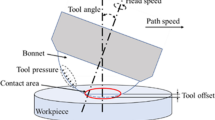Abstract
Tool path ripple error (TPR_error) is one of the main reasons due to the medium-high spatial frequency error on the surface of aspheric optics. The purpose of this paper is to analyze the effect of the tool step size to the TPR_error in sub-aperture deterministic polishing (SDP) and study a method which can optimize the tool step size to restrain this error. Three groups of simulation experiments were conducted using three different tool influence functions to simulate the uniform removal of the material. As the TPR_error is influenced by three factors, which are full width at half maximum (FWHM) of tool influence function (TIF), tool step size, and depth of material removed, each group of the experiments was conducted under the fixed TIF and depth of material removed. It turns out that both peak-to-valley (PV) and root-mean-square (RMS) values of the TPR_error become larger with the increase of the tool step size, and the variation tendency likes a reversed “L” shape curve. And, the method adopted in the simulation was further validated by the experiment. Therefore, the tool step size at the inflection point would be optimal to restrain the TPR_error together with saving the polishing time to a certain extent. This method could be used to determine the best-suited tool step size in SDP whose typical TIF is a Gaussian or Gaussian-like shape.
Similar content being viewed by others
References
Hall PR (1990) Role of asphericity on optical design. Proc SPIE 1320:384–393
Kordonski W, Golini D, Dumas P, Hogan SJ, Jacobs SD (1998) Magnetorheological suspension-based finishing technology. Proc SPIE 3326:527
Kordonski W, Gorodkin S (2011) Material removal in magnetorheological finishing of optics. Appl Opt 50(14):1984–1994
Allen LN, Romig HW (1990) Demonstration of an ion figuring process. Proc SPIE 1333:22
Jiao C, Li S, Xie X (2009) Algorithm for ion beam figuring of low-gradient mirrors. Appl Opt 48(21):4090–4096
Walker DD, Freeman R, Morton R, McCavana G, Beaucamp A (2006) Use of the ‘Precessions’TM process for prepolishing and correcting 2D & 2(1/2)D form. Opt Express 14(24):11787–11795
Walker DD, Brooks D, King A, Freeman R, Morton R, McCavana G, Kim SW (2003) The ‘Precessions’ tooling for polishing and figuring flat, spherical and aspheric surfaces. Opt Express 11(8):958–964
Wang C, Wang Z, Pan R, Peng Y, Liang K, Guo Y (2013) Effect analysis of the residual error evaluation method used in bonnet polishing process for aspheric lens. Int J Adv Manuf Technol 69(9–12):2505–2511
Zhan J (2013) Study on the manufacturing process controlling for aspheric surface ballonet polishing. Int J Adv Manuf Technol 69(1–4):171–179
Fähnle OW, Brug H, Frankena HJ (1998) Fluid jet polishing of optical surfaces. Appl Opt 37(28):6771–6773
Li Z, Li S, Dai Y, Peng X (2010) Optimization and application of influence function in abrasive jet polishing. Appl Opt 49(15):2947–2953
Shiou FJ, Loc PH, Dang NH (2013) Surface finish of bulk metallic glass using sequential abrasive jet polishing and annealing processes. Int J Adv Manuf Technol 66(9–12):1523–1533
Lee YH, Wu KL, Jhou JH (2013) Two-dimensional vibration-assisted magnetic abrasive finishing of stainless steel SUS304. Int J Adv Manuf Technol 69(9–12):2723–2733
Tsai FC, Yan BH, Kuan CY (2009) Investigation into superficial embedment in mirror-like machining using abrasive jet polishing. Int J Adv Manuf Technol 43(5–6):500–512
Jones RA (1977) Optimization of computer controlled polishing. Appl Opt 16(1):218–224
Schinhaerl M, Rascher R, Stamp R, Smith L, Smith G, Sperber P, Pitschke E (2008) Utilization of time-variant influence functions on the computer controlled polishing. Prec Eng 32(1):47–54
Ghigo M, Canestrari R, Spiga D, Novi A (2007) Correction of high spatial frequency errors on optical surfaces by means of ion beam figuring. Proc SPIE 6671:667114
Lawson JK, Aikens DM, English RE (1996) Power spectral density specifications for high-power laser systems. Proc SPIE 2775:345–356
Lawson JK, Auerbach JM, English RE, Henesian MA, Hunt JT, Sacks RA, Trenholme JB, Williams WH, Shoupe MJ, Kelly JH, Cotton CT (1998) NIF optical specifications: the importance of the RMS gradient. Proc SPIE 3492:336–343
Dai Y, Shi F, Peng X, Li S (2009) Restraint of mid-spatial frequency error in magnetorheological finishing (MRF) process by maximum entropy method. Sci China Ser E: Technol Sci 52(10):3902–3097
Hu H, Dai Y, Peng X (2010) Restraint of tool path ripple based on surface error distribution and process parameters in deterministic finishing. Opt Express 18(22):22973–22981
Yu G, Li H, Walker DD (2011) Removal of mid spatial-frequency features in mirror segments. J Eur Opt Soc, Rapid Publ 6:11044
Dunn CR, Walker DD (2008) Pseudo-random tool paths for CNC sub-aperture polishing and other applications. Opt Express 16(23):18942–18949
Walker DD, Beaucamp ATH, Bingham RG, Brooks D, Freeman R, Kim RS, King A, McCavana G, Morton R, Riley D, Simms J (2003) The precessions process for efficient production of aspheric optics for large telescopes and their instrumentation. Proc SPIE 4842:73–84
Wu J, Lu Z, Zhang H, Wang T (2009) Dwell time algorithm in ion beam figuring. Appl Opt 48(20):3930–3937
Li H, Zhang W, Yu G (2009) Study of weighted space deconvolution algorithm in computer controlled optical surfacing formation. Chin Opt Lett 7(7):627–631
Fang H, Guo P, Yu J (2006) Dwell function algorithm in fluid jet polishing. Appl Opt 45(18):4291–4296
Song C, Dai Y, Peng X (2010) Model and algorithm based on accurate realization of dwell time in magnetorheological finishing. Appl Opt 49(19):3676–3683
Wang C, Wang Z, Yang X, Sun Z, Peng Y, Guo Y, Xu Q (2014) Modeling of the static tool influence function of bonnet polishing based on FEA. Int J Adv Manuf Technol 74(1–4):341–349
Author information
Authors and Affiliations
Corresponding author
Rights and permissions
About this article
Cite this article
Wang, C., Yang, W., Ye, S. et al. Restraint of tool path ripple based on the optimization of tool step size for sub-aperture deterministic polishing. Int J Adv Manuf Technol 75, 1431–1438 (2014). https://doi.org/10.1007/s00170-014-6223-7
Received:
Accepted:
Published:
Issue Date:
DOI: https://doi.org/10.1007/s00170-014-6223-7



